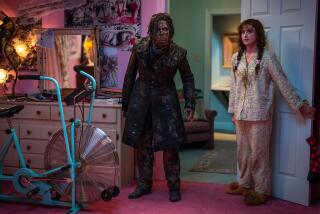Review: Loopy ‘This Must Be the Place’ has some memorable moments
The unlikeliest of road trips, “This Must Be the Place” puts a retired Goth rocker, played by Sean Penn, on the very cold trail of a Nazi war criminal. If the movie doesn’t entirely get past its hard-to-buy premise, director Paolo Sorrentino does have the courage of his convictions, not just embracing every contradiction but spinning many of the story’s contrivances into moments of strange, aching beauty.
The loopy events concern the dazed but knowing Cheyenne, with Penn striking a tricky balance between eccentricity and childlike honesty. Having rejected his career years earlier for reasons that are gradually revealed and somewhat overplayed, Cheyenne putters around his Dublin mansion and oversees a strong stock portfolio built on royalties, venturing no farther than the local mall.
Yet he still applies stage-ready maquillage daily and arranges his artful disarray of a jet-black do, à la Robert Smith of the Cure. To this mask he adds the middle-age accouterments of readers and a shopping cart.
Cheyenne moves with all the pep of the vanquished undead, and his reedy voice falls somewhere between wide-eyed wonder and barbiturate fog.
Cheyenne’s upbeat wife of 35 years (Frances McDormand, pitch-perfect) is as sturdy as he is delicate. A firefighter no less, she can engage him in a vigorous game of handball in their empty swimming pool, but she can’t lift him out of his melancholy. It takes the death of his estranged father in New York to get him really moving.
That the long-sheltered Cheyenne would board a plane by himself is questionable. But Sorrentino (“Il Divo”), who wrote the screenplay for his first English-language feature with Umberto Contarello, takes one left turn after another in this fiftysomething man’s coming-of-age story.
Cheyenne even more improbably takes the wheel for a cross-country drive to pursue the Auschwitz tormentor his father, an Orthodox Jew, was trying to track down.
Cheyenne travels through Bad Axe, Mich., and Alamogordo, N.M., with an intentionally unsatisfying showdown in Utah, unfold as a fever dream in flowery living rooms and bare-bones bars. The lurches and swoops of Luca Bigazzi’s camera sometimes enhance the narrative twists and sometimes merely call attention to themselves.
But beneath the tics, this is familiar movie territory: The road unfetters a character who’s stuck.
In what’s essentially a series of dramatic duets, every character is strongly drawn and played with an unsettling tension, with memorable turns from Judd Hirsch, Kerry Condon, Harry Dean Stanton, Joyce Van Patten and Gordon Michaels, as a tattooed barfly.
David Byrne (whose Talking Heads song provides the movie’s title) shows up as himself, delivering a nifty club performance and, in one of the less successful scenes, serving as rock ‘n’ roll confessor to the anguished Cheyenne.
The lapses in logic are undeniable, but between the freshly imagined Americana and Penn’s emotional sincerity, there’s a gratifying friction.
More to Read
Only good movies
Get the Indie Focus newsletter, Mark Olsen's weekly guide to the world of cinema.
You may occasionally receive promotional content from the Los Angeles Times.






